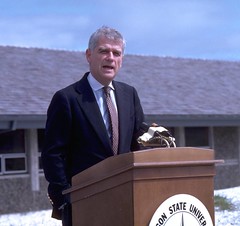 Sea Grant programs in Oregon, California and Washington have teamed to place four highly qualified young professionals in a new West Coast Sea Grant Fellowship to support regional research and information needs and advance elements of the West Coast Governors’ Agreement on Ocean Health (WCGA).
Sea Grant programs in Oregon, California and Washington have teamed to place four highly qualified young professionals in a new West Coast Sea Grant Fellowship to support regional research and information needs and advance elements of the West Coast Governors’ Agreement on Ocean Health (WCGA).
“Sea Grant has a successful record of supporting exceptional master’s and doctoral graduates for marine research and policy fellowships, and the four California, Oregon, and Washington Sea Grant Programs are thrilled to be teaming up for our first-ever regional fellowship,” said Stephen Brandt, Oregon Sea Grant Director.
Beginning this month, the four will spent two-year assignments in federal and state agency offices in California, Oregon and Washington. The fellows will work on a variety of WCGA initiatives, from developing a framework for coastal and marine spatial planning to advancing regional ocean and coastal research priorities.
Their work will support the 2008 WCGA Action Plan, which describes seven key priorities facing the West Coast:
- clean coastal waters and beaches
- healthy ocean and coastal habitats
- effective ecosystem-based management
- reduced impacts of offshore development
- increased ocean awareness and literacy among the region’s citizens
- expanded ocean and coastal scientific information, research, and monitoring
- sustainable economic development of coastal communities.
“We’re very excited to have this opportunity to benefit from the academic expertise, experience and enthusiasm of our four new fellows,” said Brian Baird, California’s Assistant Secretary for Ocean and Coastal Policy. “In these difficult economic times, working collaboratively to advance important ocean and coastal initiatives on the West Coast is critically important.”
Todd Hallenbeck will be based in the office of Oregon Governor John Kitzhaber, where he will play a key role in coastal-marine spatial planning, a science-based process for analyzing and planning for ocean and coastal use. He will assist the WCGA in developing a framework for the process, including data management, decision support tools, stakeholder engagement and policy aspects. His work will help inform region-wide marine spatial planning as he interacts with the Pacific States Marine Fisheries Commission, Pacific Fishery Management Council and various federal agencies with responsibilities for ocean and coastal activities, as well as state leadership from the three West Coast states.
Hallenbeck received his undergraduate degree in Marine Science from the Univeristy of California, Santa Cruz, and recently completed a master’s degree in Coastal Watershed Science and Policy from California State University, Monterey Bay.
Suzanna Stoike is assigned to the Washington Department of Ecology. Her work will focus on sustainable coastal communities by assisting in carrying out the soon-to-be-released implementation plan of the WCGA’s Sustainable Communities action coordination team. Suzanna will also help connect the West Coast Ecosystem-Based Network, a partnership of six community-based initiatives focused on the successful implementation of ecosystem-based management along the coasts of Washington, Oregon and California, and the NOAA/WCGA Integrated Ecosystem Assessments team.
Stoike is a recent graduate of Oregon State University’s Marine Resource Management master’s degree program, with an undergraduate degree from Coastal Carolina University in South Carolina. While at OSU, she worked with Sea Grant-funded researcher Selina Heppell on a project enlisting fishermen in Port Orford to determine whether different methods of releasing pregnant female fish can help sustain potentially overharvested species.
In addition to Stoike and Hallenbeck, the new fellowship program is placing graduates Alison Haupt with California Natural Resources Agency, and Alan Lovewell with the National Oceanic and Atmospheric Administration office in Seattle.
Launched in September 2006 by the governors of California, Oregon and Washington, the WCGA advances regional ocean governance and underscores the importance of managing activities that affect our oceans on an ecosystem basis. The governors chose the state Sea Grant programs to conduct a three-year public engagement process that gathered comments from all kinds of ocean and coastal stakeholders, public and private, and resulted in a detailed report of their issues and concerns.
From that, the WCGA team developed a 116-page action plan and eight work plans for dealing with issues as far-reaching as sea level rise, renewable energy and marine science literacy. Those plans are all available for download from the WCGA website.








